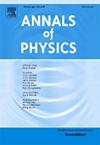小粒子的达尔文量子引力动力学
IF 3
3区 物理与天体物理
Q2 PHYSICS, MULTIDISCIPLINARY
引用次数: 0
摘要
在达尔文量子引力(DQG),也就是物理-细胞(PC)方法中,标准物理模型(SMP)通过三维无时间介质中所有SMP量子场(QF)阵列Ψ发生,其中Ψ变化在PC上发射和接收,假设具有球形格式,通过在PC之间发射和传输两种类型的量子场:QF阵列ΔΨ和QF标量δΨ。ΔΨ是基于PC内计算的SMP规则从PC发送的,因此要求每个PC处理SMP和广义相对论(GR)的4顶点费曼图所需的信息;而δΨ则与消除PC时间步长tPC的影响所需的修正的通信有关,其中δΨ的能量密度被发现等于暗能量的密度,暗能量的密度等于宇宙常数Λ。在量子场方法中,引力不是通过量子场发生的,而是通过量子场量子的同步性来发生的,量子场量子进入到量子场,而量子场量子从量子场流出,光子量子场产生了度量张量的大部分对称方面,中微子量子场产生了度量张量的大部分反对称方面。PC方法的结果是,QF退相干是由达到纯态最大能量EPC=π×ħtPC引起的,因为任何纯态波长都必须大于lPC=c×tPC,因此对于以下尺度没有物理意义。因此,对于mPC=EPCc2以上的质量,不存在超越GR的量子效应。因此,引力的量子方面只发生在非常小的质量上,这里描述这种效应。在PC方法中,lPC以下的尺度没有物理意义,通过δΨ PC之间的通信发生的插值过程,时空是连续的。本文章由计算机程序翻译,如有差异,请以英文原文为准。
Darwinian Quantum Gravity dynamics of small particles
In Darwinian Quantum Gravity (DQG), a.k.a. Physics-Cell (PC) approach, the Standard Model of Physics (SMP) occurs through a Quantum Field (QF) array of all SMP QFs within a 3D time-free medium, with alterations being emitted and received at PCs, which are assumed to have a spherical format, by the emission and transmission of two types of QFs between PCs: QF array and QF scalar . The are sent from the PCs based on the rules of the SMP calculated within the PCs, thus requiring that each PC processes the information required for a 4-vertices Feynman diagram of the SMP plus General Relativity (GR); whereas the is associated to the communication of the correction necessary to cancel the effects of the PC time-step size , with the energy density of being found to be equal to the dark energy’s density which is equal to the cosmological constant . In PC approach, gravity occurs not through a QF but by synchronicity of QF quanta incoming onto a PC with quanta of the same QF outgoing from that PC, with the photon QF generating most of the symmetric aspect of the metric tensor and the neutrino QF generating most of the antisymmetric aspect of the metric tensor. The consequences of the PC approach are that QF decoherence is caused by reaching a pure-state maximum energy of , as any pure-state wavelength must be larger than and so there is no physical meaning for scales below. Therefore, there are no quantum effects beyond GR for masses above . Thus, the quantum aspects of gravity occur only for very small masses, and such effects are described here. In the PC approach, there is no physical meaning to scales below and the spacetime is continuous through the interpolation process occurring by the communication between PCs of .
求助全文
通过发布文献求助,成功后即可免费获取论文全文。
去求助
来源期刊

Annals of Physics
物理-物理:综合
CiteScore
5.30
自引率
3.30%
发文量
211
审稿时长
47 days
期刊介绍:
Annals of Physics presents original work in all areas of basic theoretic physics research. Ideas are developed and fully explored, and thorough treatment is given to first principles and ultimate applications. Annals of Physics emphasizes clarity and intelligibility in the articles it publishes, thus making them as accessible as possible. Readers familiar with recent developments in the field are provided with sufficient detail and background to follow the arguments and understand their significance.
The Editors of the journal cover all fields of theoretical physics. Articles published in the journal are typically longer than 20 pages.
 求助内容:
求助内容: 应助结果提醒方式:
应助结果提醒方式:


